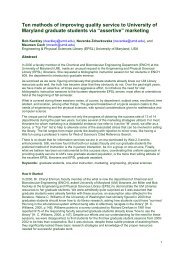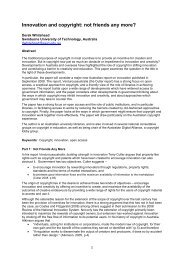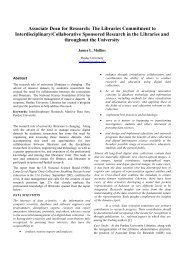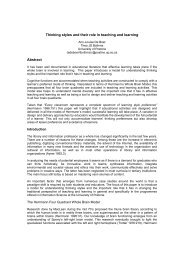Bernhard Mittermaier.pdf - IATUL
Bernhard Mittermaier.pdf - IATUL
Bernhard Mittermaier.pdf - IATUL
You also want an ePaper? Increase the reach of your titles
YUMPU automatically turns print PDFs into web optimized ePapers that Google loves.
Mitglied der Helmholtz-Gemeinschaft<br />
Bibliometric Analysis of the Output of<br />
German Technological Universities<br />
by Means of the J Factor<br />
Dr. <strong>Bernhard</strong> <strong>Mittermaier</strong>
One ranking after the other<br />
2
Academics strike back at spurious<br />
rankings<br />
Alan Gilbert, president and vice-chancellor of the<br />
University of Manchester in Britain:<br />
“All current university rankings are flawed to some<br />
extent; most, fundamentally.<br />
But rankings are here to stay, and it is therefore<br />
worth the time and effort to get them right.”<br />
NATURE, vol. 447, pp. 514-515, 31 May 2007<br />
3
Overview<br />
Basics<br />
‣ what?<br />
‣ why?<br />
‣ how?<br />
Normalization<br />
‣ J factor<br />
‣ application to TU9<br />
‣ comparison with Leiden<br />
4
What is bibliometrics?<br />
“Therefore it is suggested that a better name for this<br />
subject [statistical bibliography] is bibliometrics, i.e.<br />
the application of mathematics and statistical methods<br />
to books and other media of communication.”<br />
(Pritchard, 1969)<br />
“Bibliometrics is the quantitative study of physical<br />
published units, or of bibliographic units, or of the<br />
surrogates for either.”<br />
(Broadus, 1987)<br />
“Bibliometrics is the quantitative study of literatures as<br />
they are reflected in bibliographies.”<br />
(White & McCain, 1989)<br />
5
Overview<br />
Basics<br />
‣ what?<br />
‣ why?<br />
‣ how?<br />
Normalization<br />
‣ J factor<br />
‣ application to TU9<br />
‣ comparison with Leiden<br />
6
Bibliometrics as a tool for the<br />
evaluation of science<br />
‣ Generation of reliable, quantifiable information on<br />
scientific achievements<br />
‣ Basis for the introduction of a performance-based<br />
allocation of funds in research<br />
‣ Overcoming a mass problem by processing huge<br />
volumes of digitally available bibliometric data<br />
7
Overview<br />
Basics<br />
‣ what?<br />
‣ why?<br />
‣ how?<br />
Normalization<br />
‣ J factor<br />
‣ application to TU9<br />
‣ comparison with Leiden<br />
8
Citation rate<br />
the number of<br />
publications P<br />
depends on:<br />
CPP =<br />
C<br />
P<br />
- size of the institution<br />
- effort<br />
- (quality)<br />
- publication behaviour<br />
in the subject area<br />
the number of<br />
citations C<br />
depends on:<br />
- P<br />
- quality<br />
- citation behaviour<br />
in the subject area<br />
the citation rate CPP<br />
depends on:<br />
- quality<br />
- subject area<br />
to be measured<br />
to be normalized<br />
9
Overview<br />
Basics<br />
‣ what?<br />
‣ why?<br />
‣ how?<br />
Normalization<br />
‣ J factor<br />
‣ application to TU9<br />
‣ comparison with Leiden<br />
10
The J factor<br />
J<br />
cpp ( S)<br />
( I,<br />
R)<br />
= ∑<br />
I<br />
•<br />
cpp ( S)<br />
S<br />
R<br />
p<br />
p<br />
I<br />
( S)<br />
I , ges<br />
J(I,R): J factor of institution I, in relation to the standard R<br />
S: serial<br />
CPP I (S): average citation rate of publications by institution I in serial S<br />
CPP B (S): average citation rate of publications by standard R I in serial S<br />
p I (S): number of publications by institution I in serial S<br />
p I,ges : total number of publications by institution I<br />
11
The J factor<br />
Serial<br />
Publications<br />
Germany<br />
Citations<br />
Germany<br />
Citation<br />
rate<br />
Germany<br />
Publications<br />
Aachen<br />
Citations<br />
Aachen<br />
Citation<br />
rate<br />
Aachen<br />
Relative<br />
citation<br />
rate<br />
Aachen<br />
Weighting<br />
factor<br />
Incremental<br />
J factor<br />
S P R (S) C R (S) CPP R (S) P I (S) C I (S) CPP I (S)<br />
European<br />
Heart<br />
Journal<br />
Physics<br />
Letters B<br />
Physical<br />
Review B<br />
European<br />
Physical<br />
Journal c<br />
CPP I (S)/<br />
CPP R (S)<br />
P I (S)/<br />
P I (ges)<br />
J(I,R)incr.<br />
2,499 8,040 3.22 120 300 2.50 78 % 1.0 % 0.8 %<br />
944 17,599 18.64 117 1,357 11.60 62 % 1.0 % 0.6 %<br />
4,846 45,971 9.49 102 1,099 10.77 114 % 0.9 % 1.0 %<br />
544 6,427 11.81 100 1,493 14.93 126 % 0.9 % 1.1 %<br />
(Total) 11,443 78,369 6.85 100.0% 105.3 %<br />
J<br />
cpp ( S)<br />
( I,<br />
R)<br />
= ∑<br />
I<br />
•<br />
cpp ( S)<br />
S<br />
R<br />
p<br />
p<br />
I<br />
( S)<br />
I , ges<br />
12
Overview<br />
Basics<br />
‣ what?<br />
‣ why?<br />
‣ how?<br />
Normalization<br />
‣ J factor<br />
‣ application to TU9<br />
‣ comparison with Leiden<br />
13
TU9 - Nine major universities of<br />
technology<br />
“Excellence in engineering and<br />
the sciences made in Germany”<br />
RWTH Aachen<br />
TU Berlin<br />
TU Braunschweig<br />
TU Darmstadt<br />
TU Dresden<br />
Leibniz Universität Hannover<br />
Universität Karlsruhe (TH)<br />
TU München<br />
Universität Stuttgart<br />
http://www.tu9.de<br />
14
J Factor of TU9<br />
RWTH Aachen<br />
TU Berlin<br />
105.3%<br />
105.0%<br />
TU Braunschweig<br />
93.0%<br />
TU Darmstadt<br />
TU Dresden<br />
Leibniz Universität Hannover<br />
TH Karlsruhe<br />
100.2%<br />
102.6%<br />
102.4%<br />
103.3%<br />
TU München<br />
107.9%<br />
Universität Stuttgart<br />
TU9<br />
103.3%<br />
103.6%<br />
Germany<br />
100%<br />
85% 90% 95% 100% 105% 110%<br />
J Factor<br />
15
Overview<br />
Basics<br />
‣ what?<br />
‣ why?<br />
‣ how?<br />
Normalization<br />
‣ J factor<br />
‣ application to TU9<br />
‣ comparison with Leiden<br />
16
TU9 in various rankings<br />
Performance Shanghai Leiden Jülich Leiden Jülich<br />
ranking ranking CPP CPP CPP/FCSm J factor<br />
RWTH Aachen 2 2-5 2 3 5 2<br />
TU Berlin 7 2-5 6 7 3 3<br />
TU Braunschweig 9 6-8 8 8 9 9<br />
TU Darmstadt 6 6-8 9 9 8 8<br />
TU Dresden 3 6-8 4 4 7 6<br />
Leibniz Universität<br />
Hannover<br />
8 9 7 6 6 7<br />
TH Karlsruhe 5 2-5 3 2 2 4<br />
TU München 1 1 1 1 1 1<br />
Universität Stuttgart 4 2-5 5 5 4 5<br />
17
Leiden CPP compared to Jülich CPP<br />
P<br />
‣ more databases (?)<br />
‣ not all types of documents<br />
‣ larger publication period<br />
C<br />
‣ no self-citations<br />
‣ moving average<br />
18
Leiden FCS / FCSm<br />
“world average in a specific field / specific combination of<br />
fields” (subject category SC)<br />
means: CPP of all journals in the SC is assigned to a<br />
given journal<br />
‣ disputable assignment of journals<br />
‣ theoretical and experimental journals mixed<br />
‣ journals in one SC do not only differ in impact<br />
‣ articles counted more than once<br />
19
2007 JCR Science Edition<br />
20
2007 JCR Science Edition<br />
21
Bibliometrics to go<br />
‣ Take extreme caution when analyzing the<br />
publications of individuals.<br />
‣ Do not compare across disciplines without<br />
normalization<br />
J Factor<br />
22
Dr. <strong>Bernhard</strong> <strong>Mittermaier</strong><br />
Central Library<br />
Forschungszentrum Jülich<br />
D-52425 Jülich<br />
Germany<br />
Email: b.mittermaier@fz-juelich.de<br />
Thank you!<br />
23
















